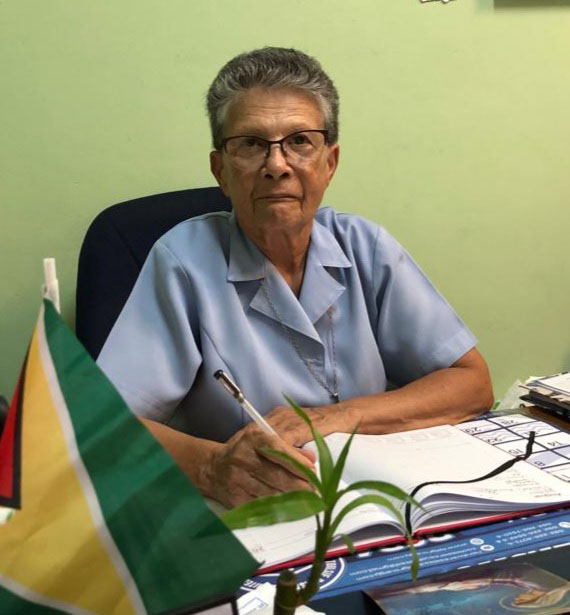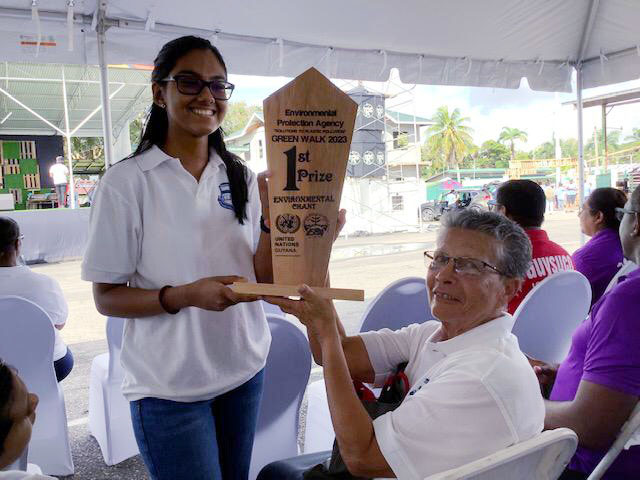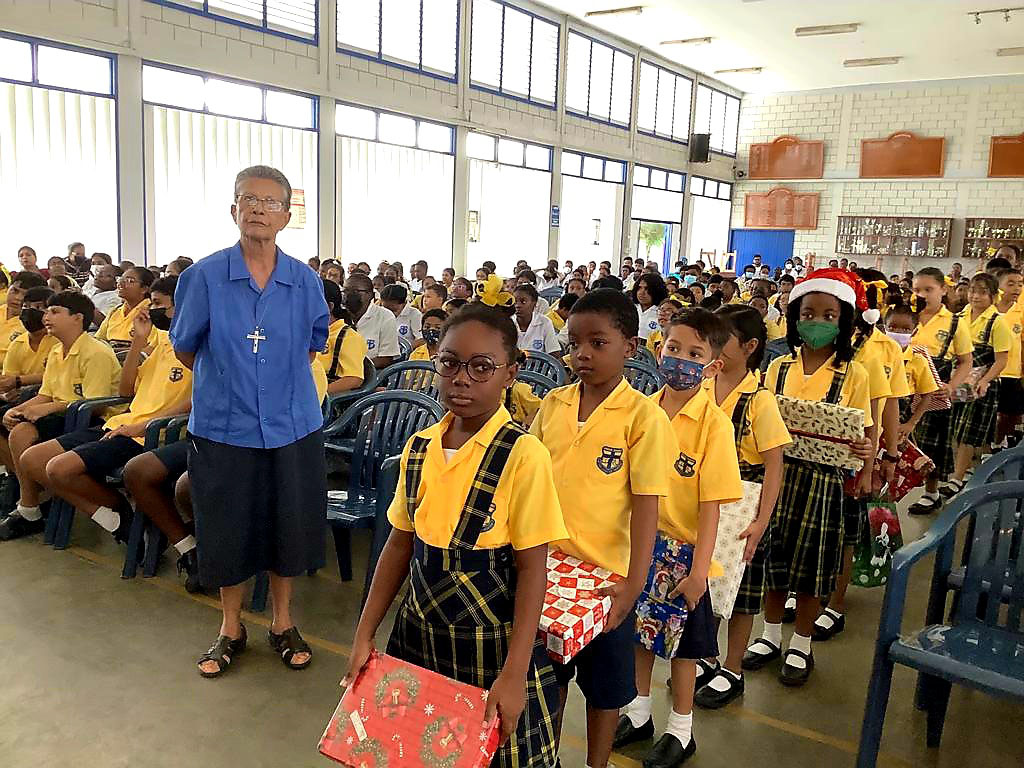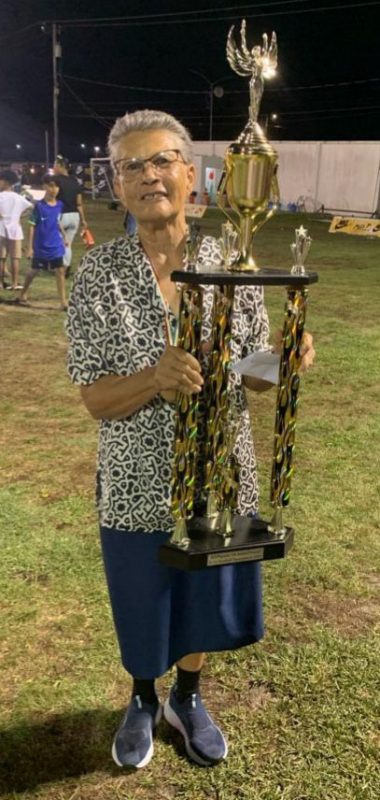After more than 55 years in the regional and local education systems of which she has dedicated 25 years to Guyana, Jamaica-born Ursuline nun Sister Marie Harper, the first principal of Marian Academy, is now set to retire. Having provided guidance, wisdom and unconditional love to thousands of children who have been in her care over the years, Sister Marie can truly be called the matriarch of Marian Academy.
She told Sunday Stabroek in an interview last week, “Here I am feeling quite satisfied for the years I’ve served Guyana. I thank God for allowing me to do that.
“Because of my religious life I came to understand education better. My religious life gave me a sense of direction and purpose in educating. I realised education was not just giving content, subject matter and information. I was educating for the sake of evangelization, to bring the good news, to enable students to live the good life.”
At present on pre-retirement, Sister Marie will continue to serve the school on the board of governors. “I will certainly try to get a long holiday,” she said, “pick up a course or two as a form of my sabbatical. Nothing exactly concrete as yet to say I’m going on this date at this place. However, I’m looking forward to living life at an easier pace.”
Asked if she does not feel like a Guyanese after living for quarter of a century in the country, she replied, “I am a Guyanese. I travel on a Guyanese passport. And yes, I’m still very Jamaican.”
Having been at the helm of Marian Academy from the beginning, overseeing the academic and building processes, Sister Marie said, “Some people wondered how on earth I was actively engaged in the process of education, in the school’s management and still monitored and offered guidance in the construction of several buildings to house the school.
“I didn’t find it a burden. It was God’s grace that steered me through this. I believe strongly that if God didn’t want me to do it, He would not have permitted it and as the scripture says, ‘God gives his people strength to do the tasks he calls them to do’.”
Educational formation
Born in Lawrence Tavern, St Andrew, Jamaica on the outskirts of Kingston “in the cool of the mountains,” Sister Marie received her formal education from kindergarten to university in Jamaica. However, she is widely travelled.
A past student of Oberlin High School in Lawrence Tavern, her tertiary education was mostly in Kingston. From St Joseph’s Teachers’ College, she obtained a certificate in secondary education. “That was important in me becoming a teacher. It was an all-female institution. The year I joined, it became coeducational. We had two young men among all the women. In those days we did a year internship of supervised teaching practice which I did at a coeducational all-age school (from nursery to Grade 13) in Spanish Town, St Catherine,” she recalled.
At teachers’ college, Sister Marie, who played netball in high school and captained her school’s house team, did physical education as a special option. Her research paper at teachers’ college was on 20th century popular dance.
“Until today I am interested in physical education. Apart from the holistic approach to education, we include a lot of physical and mental exercises in our co-curricular activities, such as chess, environmental studies, robotics and the STEM programme at Marian Academy,” she noted.
After teachers’ college, she pursued all her academic programmes at the University of the West Indies, Mona Campus. She obtained a bachelor’s degree in English and history in 1975 and in 1978 she secured a diploma in education. In 1983 she began the masters’ degree programme in education and administration but did not complete the final year because she had to take care of a sick aunt. In 1996, she returned to Mona Campus and secured a bachelor’s degree in theology.
In 1974 she joined the staff of Kingston College, an all-boys’ school where she taught for 13 years and where she moved from being a classroom teacher to coordinator for a grade level and then to vice principal.
“When I left Kingston College, 2, 227 boys were enrolled. When I got there it was just over 1,000. We had expanded to two campuses for the juniors from Grade Seven to Grade Nine and the seniors from Grade Ten to Grade 13. It was a very organised and well-managed school. We had one principal, four vice principals, year heads and coordinators at each grade level. The school had a great influence in my whole life of leadership and management,” she explained.
In 1989, Sister Marie moved to St Ursula’s all-girls school, now known as Ursuline Convent School in Barbados as the vice principal. She subsequently acted as principal before returning to Jamaica in 1992. She then moved to Academia Merici in Caracas, Venezuela in 1996 to teach English and religious education.
In August 1998, she left Venezuela and came to Guyana to formally open and run the then newly-established Marian Academy.
Religious formation
Prior to joining the staff at Kingston College, Sister Marie had that nagging feeling that God was calling her to do something different. “Not marriage, not having my own children but working with others. I shelved it numerous times but it kept on returning like a recurring decimal,” she said.
Then the Roman Catholic church gave her a scholarship to study catechesis. She first taught catechesis at St Joseph’s RC Church in St Catherine, getting children ready for first communion and adults for the rites of Christian initiation.
As a religious sister she taught catechesis at St Thomas Aquinas RC Church in Kingston, which serves the Mona Campus. In Barbados, she taught catechesis at St Patrick’s RC Church.
In Guyana she assists with the rites of Christian initiation, does presentations to confirmation classes and has taken part in days of prayers with women’s groups among others. “I serve where I am called,” she noted.
During her last year at Kingston College, she entered religious life. “I resigned from the school to pursue further studies and development in my religious life. I went to England where I received my initial formation to become a religious sister. I subsequently returned to Jamaica and I went back to study theology at UWI.”
Marian Academy
When Sister Marie came to Guyana in August 1998 she did not know what to expect. She was at the initial meeting to decide on the Ursuline nuns’ input in education here.
“Sister Jacqueline Da Silva, Sister Yvonne Searwar and other sisters were tasked to further investigate the possibility of establishing a school. They did a survey among the Catholic community and found there was an interest in returning to Catholic education. Ms Roxanna Kawall, who was literally begging for Catholic education to be reintroduced, brought the religious sisters and the clergy together to look at the issue. Sister Jacqueline Da Silva was very instrumental in the development of the school,” she recalled.
While Sister Marie was in Caracas at a provincial council meeting, the nuns received a message from Guyana asking if the Ursulines were able to provide a principal.
“The lot fell on me,” she said. “Not that anyone said, ‘Marie you should go’ but I had this deep prompting, and I asked myself, when you go to Guyana, what are you going to do? What national anthem are you going to sing? What will be your school song? Then I asked myself, are you going to Guyana? I shared my views with the sisters and they said, ‘Well what are you hearing?’ I said, I don’t know. It seems like I have to go.’ We sent a message to Sister Jackie that I would go.”
Coincidentally Marie and Marian are derivatives of Mary. “When the school was named, no one knew I was going to be principal,” she said. “It was decided to put the school under the patronage of Mary, the mother of Jesus. As a Roman Catholic school we feel that Our Lady watches over and protects our children, just like she protected her son Jesus Christ who God entrusted her with. So we, too, entrust our children to the care of our Blessed Mother.”
She resigned at the end of May and came to Guyana in August. The Guyana Veterans Legion building and the Guyana Softball Cricket Club, now the Ministry of Education Sports Complex, on Carifesta Avenue were identified to house the school. They were not ready for occupancy.
Sister Marie hit the ground running. She held meetings with hired staff and interviewed some others.
“I was even a part of buying uniforms for the nursery. All the permits that were needed to operate a school were already acquired. I had the task of carefully studying the local educational system and putting policies together. That was similar to the rest of the Caribbean so it was not too difficult. I brought all of my past experiences to help me create the school and to focus on the school’s vision,” she explained.
The school opened its doors with 227 students on 14th September 1998 and its population started to increase rapidly; there was a need for space.
“We approached Bishop Benedict Singh about the land opposite the Legion that once belonged to the Catholic Guild and he handed over the lease. There were some objections to building the school there but thank God we overcame those. Mr Carlton Joao, an engineer, who later became the chairman of the board of governors, and Mr Ken De Abreau, a lawyer, assisted in the process of obtaining permission from the necessary agencies to build. We had a tangle between the Mayor and City Council and the Ministry of Housing as to who was to give permission to build. That was sorted out. We got a good architect, Mr Ian McDavid who did the beautiful structure we now occupy,” she related.
‘Cow shed’
As the increasing student population needed space, a wooden building which some called the ‘Cow Shed’, was built at a far end of the ground to accommodate the secondary students, while awaiting the design and layout for buildings to accommodate the entire school.
“The temporary wooden building equipped with a science lab, four classrooms, a staff room and male and female washrooms, was a source of amusement to some people who had no clue what our vision was,” she recalled. “It had a corridor and the big playfield. We moved some of our secondary classes there while still continuing with other classes and administrative duties at the Legion building. That wooden building stayed there for a long time serving different purposes.”
About a year later, applications for the nursery and the primary grew rapidly. “We had to find space for them. We had formed a board of governors. On the board we had people like Barbara Stephens, a veteran in the education system and former head of St Agnes Primary for many years who gave some wise guidance. We had an active PTA,” she said.
As the architect’s design filled the ground, the primary and nursery rooms, the administrative building, the library, computer room, all the staff rooms and the hall for assembly were built to completeness.
“In the process, we placed two secondary classrooms in the two sports rooms. We also accommodated two secondary classes in the primary department,” she said.
“No sooner had we completed that phase we started the construction of the secondary. I was looking on from the Legion building when the first building was being constructed right across the road. When the secondary was being built I looked on from the primary wing to the secondary.”
She related that when the shared room/the examinations room was being built upstairs in the secondary department, the workers were putting up a wall to make it like classrooms. She told the supervisor the wall needed to come down. He objected saying it was in the drawings and he would have to ask his managers what to do.
“I had a lot of say in what we wanted in the construction of the building. It was done with consultations,” she allowed.
When the temporary wooden building was finally taken down and replaced with a new building with all amenities for the sixth forms, Sister Marie said, “We became a complete all-age school from nursery to Grade 13. We have very excellent results from the sixth form students.”
Having seen the school move from one phase to the next and from strength to strength, she said, “I’m grateful for all the knowledge I have gained. I can safely say there is not a cornerstone in that compound that I am not aware of. I have been really fortunate to see the school move from conception to maturity.”
In the process, Sister Marie learnt a lot about construction, costs, estimates and negotiating loans.
“Though Republic Bank was happy to grant us a loan, the bankers wanted to know how we were going to pay back this huge sum of money we were investing in education. This was not a factory. We had to show projection and growth. Apart from school fees, we had to show how we might pay back the loan. So we had to have fundraisers,” she said.
During the construction, to get everyone to feel a part of the process, the primary department charted the children’s contribution to a block or two on rose petals and in the secondary, contributions were recorded on thermometers.
“Not a great deal of money came from that but parents and children can today say with pride they contributed to the school’s development. We also decided to have a fair, as a designated fund for paying the loan,” she added.
Once, the PTA asked the school for some money from the fair to do a project. Sister Marie could not give that designated money and so she suggested a family day, which was the origin of the school’s family fun days.
At present the enrollment is 850. There are two classes for each grade level.
Because of oversubscription, Sister Marie has to tell past students to apply early if they want their children to follow in their footsteps. “One of my most disappointing things is telling past students, I have no place for your child. It is like telling my child I can’t keep my grandchild,” she said.
Every graduation exercise is particularly special to Sister Marie. Most of the children graduating from Marian are those who began their schooling there at the nursery level as there is limited intake at the secondary level.
“Each time we raise the Golden Arrowhead and I see the children standing to attention, I believe they are inculcating a sense of patriotism. We should not be educating to export our people. They may study and gain experiences abroad but they must return and serve the country. When I see them go and return to serve, I feel joyful. Those are high points for me,” she said.
“The joy I have of meeting my past students, seeing them grown up, having them carved their own path in life with their own family, [and] having a conversation with them as adults gives me great joy. Recently I re-emphasised that being a teacher is a great thing. You can’t be anything better than a teacher opening the minds and eyes to all the possibilities.”
Meanwhile, Marian Academy will celebrate its 25th anniversary mass on 14th January at 5 pm at the Cathedral of the Immaculate Conception. Other activities are also planned which will be highlighted on the school’s social media pages.













